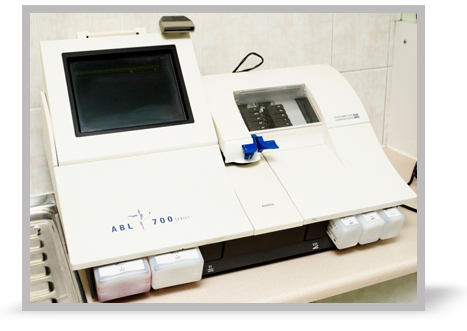
- Arterial blood gas interpretation

Introduction to arterial blood gas (ABG) interpretation
There are usually four key pieces of information contained in the analysis results of an arterial blood sample:
- pH
- PaCO2 (partial pressure of carbon dioxide in arterial blood)
- Bicarbonate and base excess (BE)
- PaO[sub]2[/sub] (partial pressure of oxygen in arterial blood)
pH
The acidity or alkalinity of blood is determined by the concentration of hydrogen ions (H+) and expressed as the pH. Normal pH lies between 7.35 and 7.45 (H[sup]+[/sup] 44-36 nmol l[sup]-1[/sup]).
Important points to remember include:
- The numerical value of pH changes inversely with H[sup]+[/sup]concentration. A decrease in blood pH below 7.35 indicates an increase in H[sup]+[/sup], a condition called an acidaemia. An increase in pH above 7.45 indicates a decrease in H[sup]+[/sup], a condition called an alkalaemia
- Small changes in pH represent large changes in H[sup]+[/sup] concentration
PaCO2
CO2 is a waste product of metabolism. Normally it is transported to the lungs in two ways:
- Combined with protein or haemoglobin
- Dissolved in plasma, where it reacts with water to form hydrogen ions (H+) and bicarbonate (HCO[sub]3[/sub][sup]-[/sup])
CO[sub]2[/sub] behaves as an acid as it results in the production of H[sup]+[/sup]. The key determinant of PaCO[sub]2[/sub] is alveolar ventilation; a decrease reduces excretion of CO[sub]2[/sub], increasing H[sup]+[/sup]. If the pH decreases below 7.35, with a high PaCO[sub]2[/sub], this is called a respiratory acidosis.
If the pH increases above 7.45, with a low PaCO[sub]2[/sub], this is called a respiratory alkalosis.
The normal PaCO[sub]2[/sub] is 5.3 kPa with a range of 4.7-6.0 kPa.
Bicarbonate
Bicarbonate (HCO3-) is the most important buffer. It is generated by the kidneys and easily measured in an arterial blood sample.
When bicarbonate buffers hydrogen ions, CO[sub]2[/sub] and H[sub]2[/sub]O are produced. It is by this route that the vast majority of acids are excreted each day. Acids not eliminated by the respiratory system can also be buffered, and in the kidneys H[sup]+[/sup] is excreted in the urine and bicarbonate is filtered and returned to the plasma. Depending on the acid load the kidneys will excrete either acid or alkaline urine.
Any acute increase in acid load will result in the respiratory system trying to increase excretion of CO[sub]2[/sub] and the use of bicarbonate to buffer the extra H[sup]+[/sup]. The kidneys can only respond slowly to produce more bicarbonate and until they do, the pH will fall. If the pH decreases below 7.35, with a low bicarbonate, this is called a metabolic acidosis.
The normal concentration of bicarbonate is 22-26 mmol l[sup]-1[/sup].
Base excess (BE)
Base excess (BE) is a measure of the amount of excess acid or base that is in the blood as a result of a metabolic derangement.
It is calculated as the amount of strong acid or base that would have to be added to a blood sample with an abnormal pH to restore it to normal (pH 7.4).
The normal values of base excess (BE) are +2 to
-2 mmol l -1. A base excess (BE) that is:
- More negative than -2 mmol l [sup]-1[/sup] (negative base excess) and pH less than 7.35 indicates a metabolic acidosis
- Greater than +2 mmol l [sup]-1[/sup] (base excess) and pH greater than 7.45 indicates a metabolic alkalosis
PaO2
The concentration of oxygen in inspired air is 21%, a partial pressure of 21kPa. This reduces to 13kPa as air passes down the respiratory tract, due to the addition of water vapour in the tract and CO2 in the alveoli.
The partial pressure of oxygen in arterial blood is always lower than alveolar; the extent of this gradient is determined by the presence of any lung disease. In a healthy individual breathing air, the PaO[sub]2[/sub] is normally higher than 11 kPa (i.e. about 10kPa lower than the inspired partial pressure).
As a rule of thumb the PaO[sub]2[/sub] should be numerically 10 less than the inspired concentration. For example, 40% inspired oxygen should result in a PaO[sub]2[/sub] of approximately 30 kPa. Lung injury increases the gap between inspired concentration and PaO[sub]2[/sub]. For someone breathing 50% oxygen a PaO[sub]2[/sub] of 13 kPa is not “normal”.
References
Essentials: 5-step approach to ABG interpretation
Step 1 – how is the patient?
Step 2 – is the patient hypoxaemic?
Step 3 – is the patient acidaemic or alkalaemic?
Step 4 – what happened to the PaCO2?
Step 5 – what has happened to the base excess (BE) or bicarbonate?
